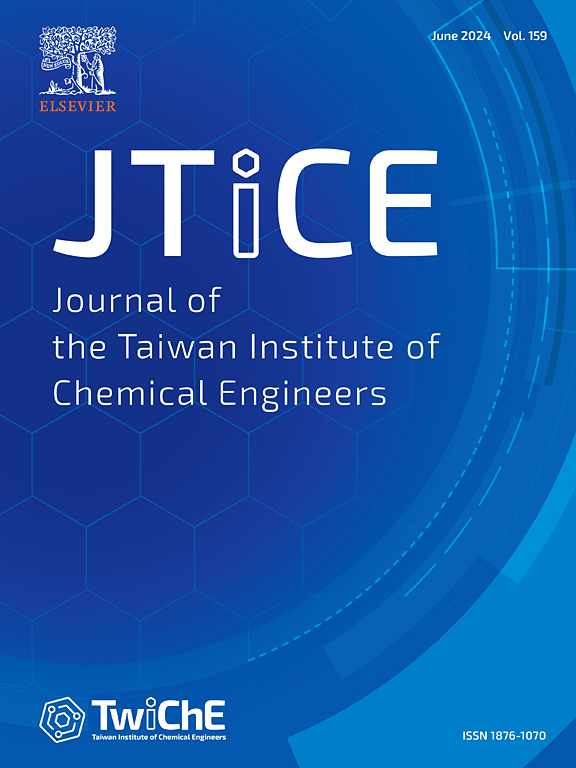Sun-light-driven Z-scheme photocatalytic annihilation of Rhodamine B, Hydrogen production and stability assessment via facile hydrothermal preparation of novel nanocomposite Nb2O5/TiS2
IF 5.5
3区 工程技术
Q1 ENGINEERING, CHEMICAL
Journal of the Taiwan Institute of Chemical Engineers
Pub Date : 2025-01-25
DOI:10.1016/j.jtice.2025.105976
引用次数: 0
Abstract
Background
Two major threats to modern society are the energy problem and water pollution. Currently, developing photocatalysts that possess both high activity and recyclability to break down pollutants remains a difficult task. The study presents a photocatalyst known as the Nb2O5/TiS2 heterojunction.
Methods
This photocatalyst is created by applying TiS2 onto the surface of Nb2O5 concurrently, using the hydrothermal approach. We used various methods, such as XRD, SEM, UV–vis, BET, PL, EIS, PC, Raman, and FT-IR, to examine the crystallinity, morphology, structure, surface area, and optical qualities of the as-prepared samples.
Significant findings
The Nb2O5/TiS2@5 % photocatalyst has the ability to broaden the range of visible light that it can absorb, as well as aid in the efficient separation and transfer of charges. The enhanced light absorption, superior absorbability, smaller band gap, and higher rate of separation of photo-generated charge carriers are all responsible for the increased photocatalytic activity as well as the higher hydrogen production. It was also observed that by the increasing in the ratio of TiS2 in pure Nb2O5 the features like crystallinity, optical and morphology was also enhanced. When exposed to visible light irradiation, the breakdown rate of Rhodamine B reached its highest point (99 %) in just 56 min. Furthermore, the synthesized photocatalyst showed excellent versatility, durability, and recyclability. We developed a Z-scheme transfer channel to enhance the photocatalytic performance based on findings from radical trapping studies, optical analysis, and photo-electrochemical analysis.The Nb2O5/TiS2@5 % photocatalyst produced more hydrogen gas (14.8 mmol/gh) than their singlet components (Nb2O5, TiS2). The optimized nanocomposite (Nb2O5/TiS₂@5 %) has great reductive and oxidative properties, and the Z scheme operation makes it much more stable. This photocatalyst worked exceptionally well for deterioration, producing hydrogen quickly and efficiently. These factors make it much better for use in photocatalysis and hydrogen production.

求助全文
约1分钟内获得全文
求助全文
来源期刊
CiteScore
9.10
自引率
14.00%
发文量
362
审稿时长
35 days
期刊介绍:
Journal of the Taiwan Institute of Chemical Engineers (formerly known as Journal of the Chinese Institute of Chemical Engineers) publishes original works, from fundamental principles to practical applications, in the broad field of chemical engineering with special focus on three aspects: Chemical and Biomolecular Science and Technology, Energy and Environmental Science and Technology, and Materials Science and Technology. Authors should choose for their manuscript an appropriate aspect section and a few related classifications when submitting to the journal online.

 求助内容:
求助内容: 应助结果提醒方式:
应助结果提醒方式:


